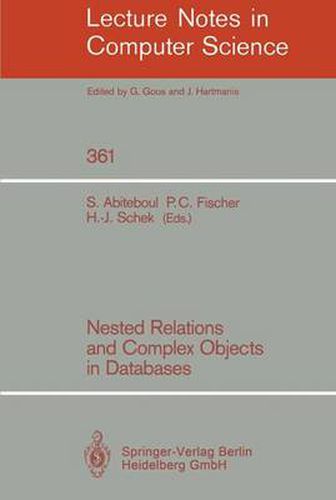Readings Newsletter
Become a Readings Member to make your shopping experience even easier.
Sign in or sign up for free!
You’re not far away from qualifying for FREE standard shipping within Australia
You’ve qualified for FREE standard shipping within Australia
The cart is loading…






This title is printed to order. This book may have been self-published. If so, we cannot guarantee the quality of the content. In the main most books will have gone through the editing process however some may not. We therefore suggest that you be aware of this before ordering this book. If in doubt check either the author or publisher’s details as we are unable to accept any returns unless they are faulty. Please contact us if you have any questions.
This volume was primarily intended to present selected papers from the workshop on Theory and Applications of Nested Relations and Complex Objects, held in Darmstadt, FRG, from April 6-8, 1987. Other papers were solicited in order to provide a picture of the field as general as possible. Research on nested relations and complex objects originates in the late seventies. The motivation was to obtain data models and systems which would provide support for so-called complex objects or molecular structures, i.e., for hierarchically organized data, thereby overcoming severe shortcomings of the relational model. This theme of research is now maturing. Systems based on those ideas are beginning to be available. Languages of various natures (algebras, calculi, graphical, logic-oriented) have been designed and a theory is slowly emerging. Finally, new developments in database technology and research are incorporating features of models involving complex objects. A variety of approaches is represented in this volume. The first three papers give overviews of major pioneering implementation efforts. The fourth paper is devoted to the important issue of implementation of storage structures. The next three papers propose excursions in the foundations of nested relations and complex objects. The following six contributions are all devoted to modeling of complex objects. The area of database design is represented by the last four papers.
$9.00 standard shipping within Australia
FREE standard shipping within Australia for orders over $100.00
Express & International shipping calculated at checkout
Stock availability can be subject to change without notice. We recommend calling the shop or contacting our online team to check availability of low stock items. Please see our Shopping Online page for more details.
This title is printed to order. This book may have been self-published. If so, we cannot guarantee the quality of the content. In the main most books will have gone through the editing process however some may not. We therefore suggest that you be aware of this before ordering this book. If in doubt check either the author or publisher’s details as we are unable to accept any returns unless they are faulty. Please contact us if you have any questions.
This volume was primarily intended to present selected papers from the workshop on Theory and Applications of Nested Relations and Complex Objects, held in Darmstadt, FRG, from April 6-8, 1987. Other papers were solicited in order to provide a picture of the field as general as possible. Research on nested relations and complex objects originates in the late seventies. The motivation was to obtain data models and systems which would provide support for so-called complex objects or molecular structures, i.e., for hierarchically organized data, thereby overcoming severe shortcomings of the relational model. This theme of research is now maturing. Systems based on those ideas are beginning to be available. Languages of various natures (algebras, calculi, graphical, logic-oriented) have been designed and a theory is slowly emerging. Finally, new developments in database technology and research are incorporating features of models involving complex objects. A variety of approaches is represented in this volume. The first three papers give overviews of major pioneering implementation efforts. The fourth paper is devoted to the important issue of implementation of storage structures. The next three papers propose excursions in the foundations of nested relations and complex objects. The following six contributions are all devoted to modeling of complex objects. The area of database design is represented by the last four papers.